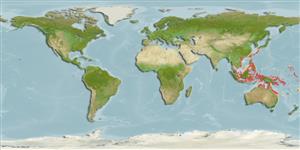Teleostei (teleosts) >
Blenniiformes (Blennies) >
Blenniidae (Combtooth blennies) > Salariinae
Etymology: Salarias: Latin, salar, salaris = trout (Ref. 45335).
More on author: Bleeker.
Environment: milieu / climate zone / depth range / distribution range
Ecology
Marine; reef-associated; depth range 1 - 10 m (Ref. 48636). Tropical
Western Central Pacific: Philippines, Indonesia (Ref. 393) and Papua New Guinea (Ref. 6192) also reported from Heron Island (Brian Mayes, pers. comm., brian@mayescai.freeserve.co.uk).
Size / Weight / Age
Maturity: Lm ? range ? - ? cm
Max length : 15.0 cm TL male/unsexed; (Ref. 393)
Series of dark blotches along the body. The most darkened chest and belly distinguishes this species from the similar Salarias fasciatus. In addition, S. ceramensis has 15 pectoral fin rays, S. fasciatus only has 14 (Ref. 48636).
Facultative air-breathing (Ref. 126274); Adults occur solitary on dead corals (Ref. 90102) in sheltered bays and lagoons, often silty habitat, amongst mixed algae and coral rubble to about 10 m depth (Ref. 48636). Oviparous. Eggs are demersal and adhesive (Ref. 205), and are attached to the substrate via a filamentous, adhesive pad or pedestal (Ref. 94114). Larvae are planktonic, often found in shallow, coastal waters (Ref. 94114). Minimum depth of 1 m reported from Ref. 90102.
Life cycle and mating behavior
Maturity | Reproduction | Spawning | Eggs | Fecundity | Larvae
Oviparous, distinct pairing (Ref. 205).
Rau, N. and A. Rau, 1980. Commercial marine fishes of the Central Philippines (bony fish). German Agency for Technical Cooperation, Germany. 623 pp. (Ref. 393)
IUCN Red List Status (Ref. 130435)
Threat to humans
Harmless
Human uses
Fisheries: minor commercial; aquarium: commercial
More information
ReferencesAquacultureAquaculture profileStrainsGeneticsElectrophoresesHeritabilityDiseasesProcessingNutrientsMass conversion
Tools
Special reports
Download XML
Internet sources
Estimates based on models
Preferred temperature (Ref.
123201): 26.8 - 29.3, mean 28.8 °C (based on 1595 cells).
Phylogenetic diversity index (Ref.
82804): PD
50 = 0.5001 [Uniqueness, from 0.5 = low to 2.0 = high].
Bayesian length-weight: a=0.00741 (0.00335 - 0.01640), b=3.02 (2.83 - 3.21), in cm total length, based on LWR estimates for this (Sub)family-body shape (Ref.
93245).
Trophic level (Ref.
69278): 2.0 ±0.00 se; based on food items.
Resilience (Ref.
120179): High, minimum population doubling time less than 15 months (Preliminary K or Fecundity.).
Fishing Vulnerability (Ref.
59153): Low vulnerability (10 of 100).
Nutrients (Ref.
124155): Calcium = 119 [58, 205] mg/100g; Iron = 0.749 [0.423, 1.314] mg/100g; Protein = 18 [17, 19] %; Omega3 = 0.0741 [, ] g/100g; Selenium = 23 [11, 52] μg/100g; VitaminA = 101 [25, 409] μg/100g; Zinc = 2.32 [1.53, 3.38] mg/100g (wet weight);
